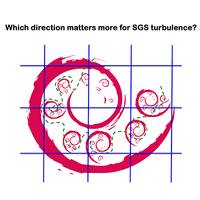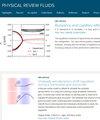Hidden mechanism of dynamic large-eddy simulation models
IF 2.5
3区 物理与天体物理
Q2 PHYSICS, FLUIDS & PLASMAS
引用次数: 0
Abstract
The dynamic model is one of the most successful inventions in subgrid-scale (SGS) modeling as it alleviates many drawbacks of the static coefficient SGS stress models. The model coefficient is often calculated dynamically through the minimization of the Germano-identity error (GIE). However, the driving mechanism behind the dynamic model's success is still not well understood. In wall-bounded flows, we postulate that the principal directions of the resolved rate-of-strain tensor play an important role in the dynamic models. Specifically, we find that minimization of the GIE along only the three principal directions (or less), in lieu of the nine components in its original formulation, produces equally comparable results as the original model when examined in canonical turbulent channel flows, a three-dimensional turbulent boundary layer, and a separating flow over periodic hills. This suggests that not all components of the Germano identity are equally important for the success of the dynamic model, and that there might be dynamically more important directions for modeling the subgrid dynamics.

动态大涡流模拟模型的隐藏机制
动态模型是亚网格尺度(SGS)建模中最成功的发明之一,因为它减轻了静态系数 SGS 应力模型的许多缺点。模型系数通常是通过最小化日耳曼识别误差(GIE)来动态计算的。然而,人们对动态模型成功背后的驱动机制仍不甚了解。在壁面约束流中,我们推测解析应变速率张量的主方向在动态模型中发挥了重要作用。具体来说,我们发现,在典型湍流通道流、三维湍流边界层和周期性山丘上的分离流中,仅沿三个主方向(或更少)最小化 GIE,而不是其原始表述中的九个分量,所产生的结果与原始模型具有同等可比性。这表明,杰尔曼诺特性的所有组成部分对于动态模型的成功并不都是同等重要的,可能存在对子网格动态建模更为重要的动态方向。
本文章由计算机程序翻译,如有差异,请以英文原文为准。
求助全文
约1分钟内获得全文
求助全文
来源期刊

Physical Review Fluids
Chemical Engineering-Fluid Flow and Transfer Processes
CiteScore
5.10
自引率
11.10%
发文量
488
期刊介绍:
Physical Review Fluids is APS’s newest online-only journal dedicated to publishing innovative research that will significantly advance the fundamental understanding of fluid dynamics. Physical Review Fluids expands the scope of the APS journals to include additional areas of fluid dynamics research, complements the existing Physical Review collection, and maintains the same quality and reputation that authors and subscribers expect from APS. The journal is published with the endorsement of the APS Division of Fluid Dynamics.
 求助内容:
求助内容: 应助结果提醒方式:
应助结果提醒方式:


